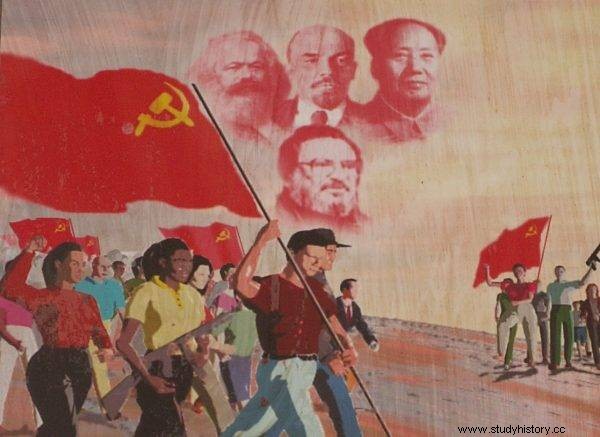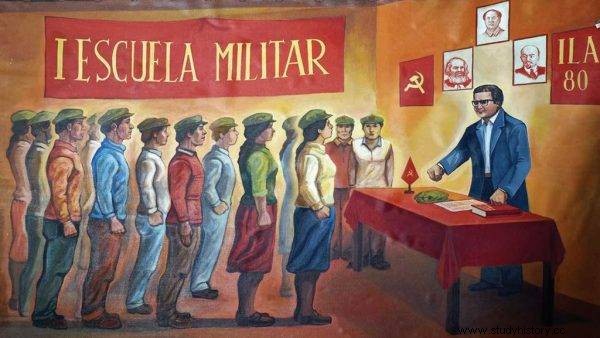They started a civil war in which 70,000 people were killed. They killed, tortured and planted bombs in the name of revolution. Speech of the Shining Path guerrillas.
Latin America was home to many leftist guerrillas. The US-backed military dictatorships and the related poverty generated social resistance. It found an outlet in the organization of armed struggle. Another thing is that often partisans, tired of years of fruitless trials, departed from noble ideals in favor of a mere bandit or just drug trafficking. One of the guerrilla groups stood out in particular. Peruvian Shining Trail ( Sendero Luminoso ) showed the highest level of violence, radicalism and… detachment from reality.
Radical Maoists
The whole story is complicated and simple at the same time. There was a communist party in Peru, from which a Maoist faction split in 1964. However, even this Communist Party of Peru - Red Banner (Partido Comunista Peruano - Bandera Roja) for Abimel Guzmán and his sixteen companions, it was not radical enough. So at the end of the 1960s, they decided to make another split. This is how the Communist Party of Peru - Shining Path was created . The name comes from one of the slogans:"Through the luminous Mariátegui trail". (Mariátegui is the name of one of the most important Peruvian communists).

Guzmán became "head of the party and revolution", and one of the slogans of the movement was:"Apart from power, everything is an illusion."
Throughout the 1970s, the Shining Trail developed its structures. However, it never became a mass organization. Its members could be counted in the hundreds at best . At the same time, his ideology became more and more radical and paranoid. Guzmán became "head of the party and revolution", and one of the slogans of the movement was:"Apart from power, everything is an illusion."
In 1979, members of the Shining Path (also known as Senderists) decided to start fighting. The following year, they carried out their first military action, which went almost unnoticed. But there were many, many more after it…
What were they fighting for?
We should start with the ideology that guided the fighters. Its core was communism, and more specifically Maoism understood in a specific way. The greatest contribution to the "development" of the ideology of the Shining Path was made by the aforementioned Abimael Guzmán, known under the pseudonym "President Gonzalo". Although we are talking about a relatively small partisan all the time, the size of his cult can only be compared with the USSR under Stalin and China under Mao.
The Shining Path propaganda called him "the greatest living Marxist in the world" and "the fourth sword of Marxism" (after Marx, Lenin and Mao). Sometimes she even wrote about "gonzalism" as a creative development of Marx's theory. According to Guzmán, the ideal way to organize society would be self-sufficient peasant communes, excluded from market mechanisms and producing for their own needs. It is not difficult to guess that it was a utopian vision, which could not be implemented even in the areas controlled by Senderists.

The Shining Path propaganda called him "the greatest living Marxist in the world" and "the fourth sword of Marxism" (after Marx, Lenin and Mao).
Mao was also a very important figure for the partisans of the Trail. This is evidenced by the action they carried out on December 26, 1980 in Lima. They hanged the bodies of stray dogs on the street lamps in the most important streets of the Peruvian capital with cards stuck to it that read:"Teng Hsiao-Ping hijo deperra" ("Son of a bitch Deng Xiaoping"). It was a criticism of the reforms made by a Chinese leader who had departed from Maoist orthodoxy. I wonder if anyone heard about this in China?
The relationship between the Shining Trail and the peasants is also interesting. After all, for the Maoists it was this layer of society that was the most important because it was the basis for the revolution. But what worked great in theory had no bearing on practice.
Killings and torture
The mother of the Senderists was the Andean region of Ayacucho - rather not densely populated, conservative and poor. There, in some more remote villages, partisans already in 1982 banned the sale of agricultural products and the organization of fairs where they traded with nearby settlements. Obviously, this did not lead to increased prosperity. The peasant dissatisfaction started to grow quite quickly.
In order to suppress them, the Trail resorted to really brutal methods. Anyone who expressed criticism in any way could be punished. Sentenced to death guerrillas slit their throats or smash their heads with stones. As they themselves claimed - "to save ammunition". One of the witnesses referred to the story of a woman who criticized the unfair distribution of crops. The People's Court gave her 50 lashes and shaved her head. One man, guilty of a similar "crime", also received 50 lashes and had his ears cut off. In turn, a postal worker, accused of being an informant, was castrated as part of revenge. Additionally, the guerrillas cut off his tongue.

In the 1980s and at the beginning of the next decade, members of the Luminous Trail regularly performed massacres
During the 1980s and the beginning of the next decade, members of the Luminous Path regularly carried out massacres - such as the one in Lucanamarca, where on April 3, 1983, a group of 80 Senderists killed a total of 69 people (including children and the elderly).
There was understandable resistance to such practices. The peasants began to form self-defense groups. The trail, in order not to lose its social base, decided to relocate the population. As a result, as many people as possible remained under his control. The conditions in the displaced persons camps were appalling. People lived in plastic tents. The food supply was a constant problem. There was a shortage of salt, sugar or fresh vegetables . Many people were starving. When in October 1993 one of these camps was taken over by the military, it turned out that all of its inhabitants suffered from anemia. In addition, some had tuberculosis, bronchitis, and malaria. Some of the children were unable to walk due to malnutrition.
The fall of the Shining Path
Although the Shining Trail seemed to be at its peak in the early 1990s, its end came suddenly and unexpectedly. Abimael Guzmán, along with part of the guerrilla leadership, was captured on September 12, 1992. Although remained at large guerilleros they tried to continue their terrorist activities , it did not have the same momentum as before. In addition, President Gonazalo soon after his imprisonment began to call for negotiations with the government, prompting many partisans to desert.
The military also changed its strategy. Every Andean peasant has ceased to be considered a potential terrorist, which has definitely increased confidence in the armed forces. The Shining Trail degenerated more and more, becoming a group of common criminals and drug dealers with time. Although it still exists and attacks occasionally, it cannot be compared to the terror of the 1980s.
